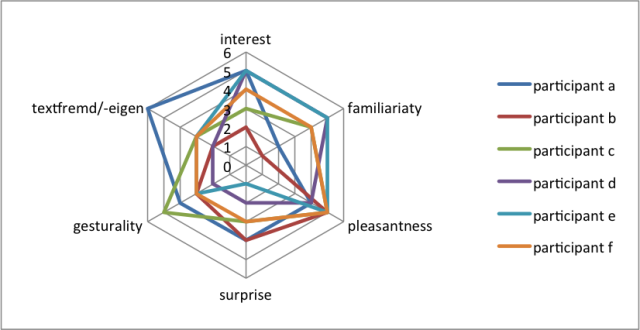The psychological track studies both the artistic creative process as well the perception of the finished performance. It consists of both qualitative and empirical methods in a blended, synthetic approach creating an array of interpretation methods and extensive data sets.
Quantitative methods. The empirical experiment will focus on the perception of effort in musical content, and the mappings between the auditory and visual domains and their interactions. The study uses Continuous Self-Report Methods, which are widely used in evaluation of emotional response to music. Subjects rate perceived effort in eleven short segments from a video recording of a live performance of Helmut Lachenmann’s Pression for solo cello. The performance is assessed based on either audio or video. The goals are to find out, how similar or different the ratings would be based on audio or video, which modality dominates the perception and what are the contributing factors.
Results from a recent pilot experiment showed surprisingly similar ratings in the audio and video conditions. Perception through the two modalities was contradicted, when soft audio was combined with movement in the video, or if loud and/or unpleasant audio is combined with peaceful bowing of the left hand. It is a future goal to find out, what the total percept would be in these mismatch situations.
Qualitative methods. A custom-tailored online survey is set up alongside the empirical experiment consisting of general subjective impression ratings and multiple choice gesture categorisation combined with open format questions about the same segments. The respective questions and topics were derived from literature with additions from the ongoing research project itself (e.g. a measure of general “gesturality” of the segment). Most of the categories of the mindmap from the music analysis strand were covered and tested. As a consequence, continuous ratings of the empirical experiment can be complemented and informed by the survey’s results.
Preliminary insights and results were the optimisation of the survey tool during the pilot phase as well as descriptive statistics with respective interpretation. Generally, the participants showed agreement in the gestural categorisation of most segments. Disagreement is temporarily interpreted as an issue of conceptual understanding or individual subjective bias of interest. In the case of the described modal mismatch above, the survey is able to contribute insights from the ratings of surprise and pleasantness.
A “puristic” qualitative research track started to accompany the inception, rehearsal and performance of the pieces of the artistic practice applying techniques of observation, participation and interviews. It is meant to evaluate the research progress “in the field” of artistic practice and establish a bi-directional exchange between theory and practice.

